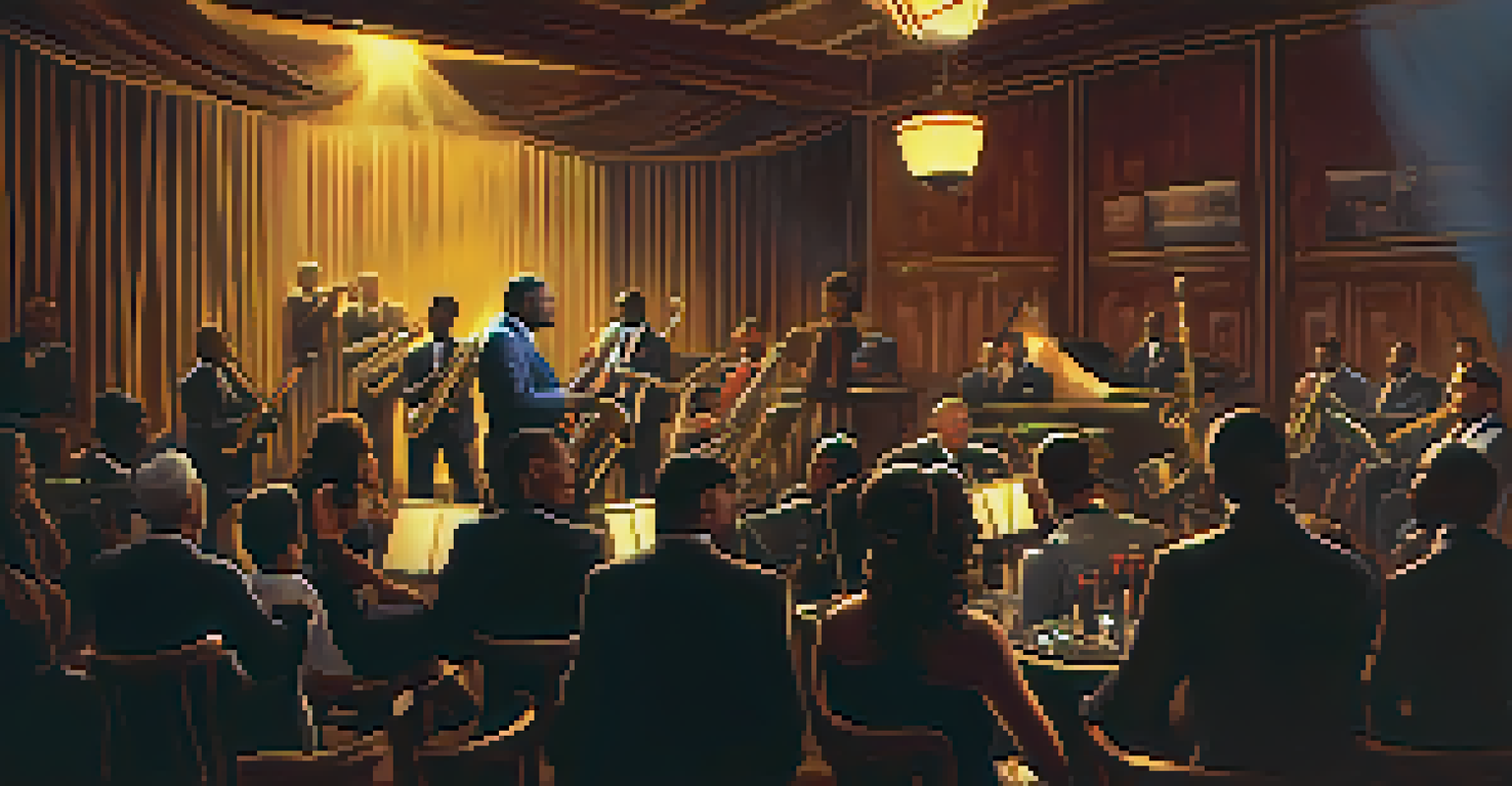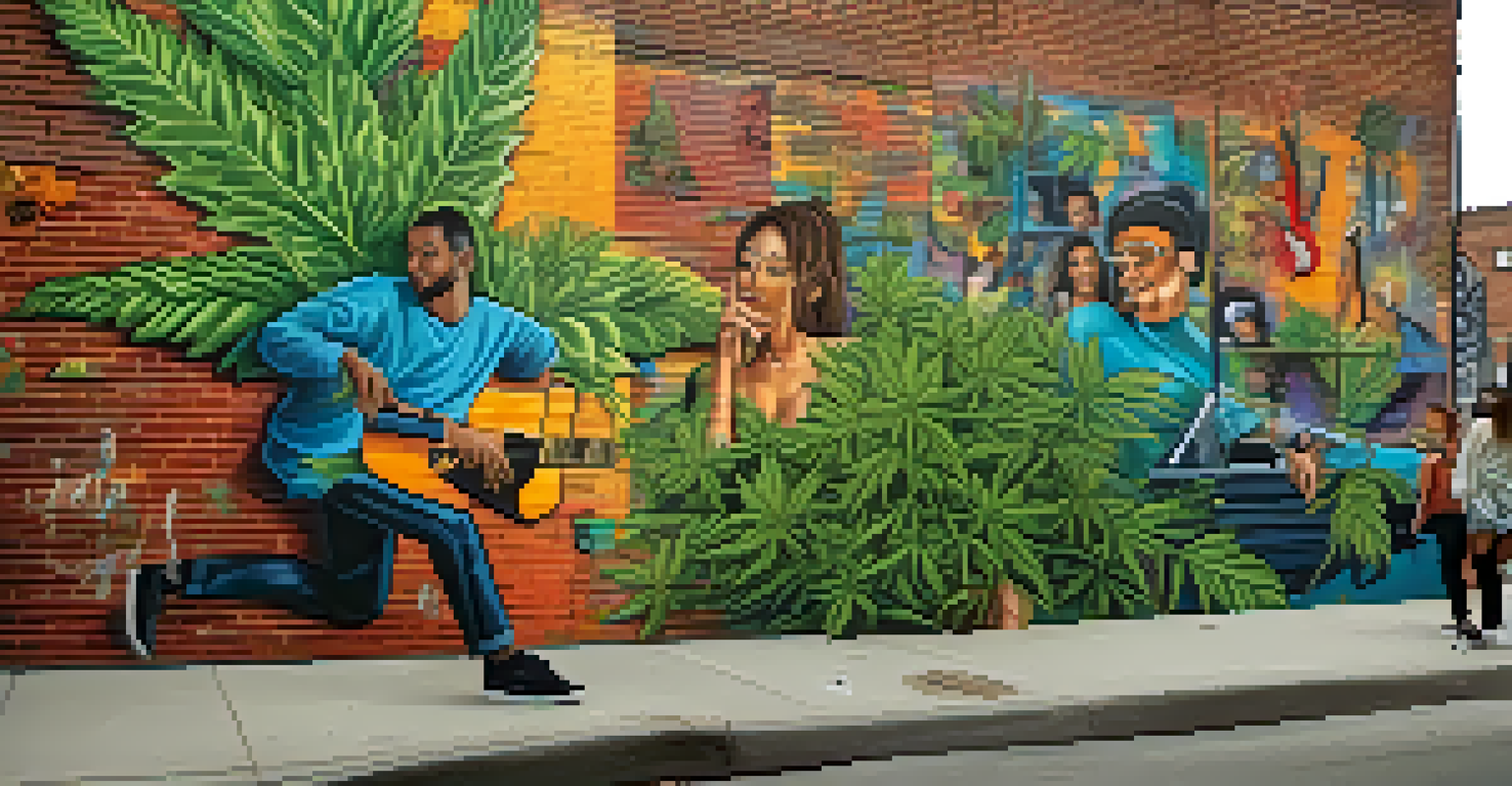The Evolution of Marijuana in Music: A Cultural Journey

The Origins: Marijuana in Early Music
Marijuana has a long history intertwined with music, dating back centuries. In various cultures, it has been used in rituals and gatherings, enhancing the communal experience. For instance, in African and Caribbean traditions, cannabis was often smoked to facilitate creativity and connection among musicians.
Music can change the world because it can change people.
These early associations laid the groundwork for how marijuana would influence musical expression. The free-spirited nature of folk and world music often embraced this herb, as artists sought to expand their consciousness and creativity. It was during these formative years that the seeds of cannabis in music were sown.
As we delve deeper into history, it's clear that marijuana wasn't just a substance but a cultural catalyst. This connection between music and marijuana became more pronounced as artists began to explore themes of rebellion and freedom.
The Jazz Age: Cannabis and Creativity
The 1920s brought about a revolution in music, particularly with the rise of jazz. Musicians like Louis Armstrong openly embraced marijuana, crediting it with enhancing their creativity and performance. Jazz clubs became hubs of experimentation, where the smoky haze of cannabis mingled with the sounds of saxophones and trumpets.

This era highlighted the relationship between marijuana and improvisation, a cornerstone of jazz music. Artists often found that using cannabis allowed them to break free from traditional structures and explore new musical territories. The spontaneity and fluidity of jazz were, in many ways, a reflection of this newfound freedom.
Marijuana's Cultural Influence on Music
Throughout history, marijuana has served as a cultural catalyst, enhancing creativity and community among musicians across various genres.
As jazz grew in popularity, so did the perception of marijuana as a cultural symbol. It became associated with the bohemian lifestyle, signifying artistic expression and rebellion against societal norms.
The 1960s: A Revolution in Music and Mindset
The 1960s marked a significant turning point in both music and the cultural landscape, with marijuana becoming a symbol of the counterculture movement. Iconic bands like The Beatles and The Grateful Dead openly incorporated cannabis into their creative processes, using it as a tool for exploration and connection.
The only thing better than singing is more singing.
This decade also saw the emergence of psychedelic rock, where the influence of marijuana was unmistakable. Lyrics became more abstract, and musical experimentation took center stage, reflecting the broader societal shifts of the time. The melding of music and marijuana was a natural fit, as both sought to transcend conventional boundaries.
Festivals like Woodstock became synonymous with this cultural shift, where music and marijuana flowed freely. The experience of being part of a larger community while under the influence of cannabis contributed to a sense of unity and shared purpose among attendees.
Reggae and Rasta: Marijuana as Spiritual Symbol
In the 1970s, reggae music emerged as a powerful voice for social change, with marijuana playing a vital role in its cultural narrative. Rooted in Rastafarian beliefs, cannabis became a symbol of spiritual connection and resistance against oppression. Artists like Bob Marley used their platforms to promote the herb as a means of achieving higher consciousness.
The message of love, peace, and unity was amplified through the sounds of reggae, with marijuana often featured in lyrics and live performances. This connection turned cannabis into a cultural emblem, representing not just pleasure, but a profound sense of purpose.
Jazz and Cannabis: A Creative Bond
The 1920s jazz scene showcased how marijuana fueled improvisation and artistic expression, becoming a symbol of the bohemian lifestyle.
As reggae gained international recognition, so did the association between the genre and the use of marijuana. This cultural synergy contributed to the global perception of cannabis as a symbol of liberation and self-expression.
Hip-Hop: The Rise of Cannabis Culture
The 1980s and 1990s saw the rise of hip-hop, a genre that would further intertwine marijuana with music culture. Artists like Snoop Dogg and Cypress Hill made cannabis a staple in their lyrics and personas, celebrating its use and promoting a laid-back lifestyle. The imagery of smoking and partying became iconic in music videos and album covers.
Hip-hop's relationship with marijuana also highlighted themes of rebellion and resilience. As artists navigated their environments, cannabis became a form of self-expression and a way to cope with societal challenges. The music not only reflected their realities but also influenced listeners in profound ways.
This era solidified marijuana's place in mainstream music culture, with hip-hop serving as a vehicle for cannabis advocacy and normalization. The blend of beats and marijuana culture created a unique identity that resonated with a generation.
Modern Music: Cannabis in the Digital Age
Today, the evolution of marijuana in music continues to thrive, especially with the rise of digital platforms. Artists now have the ability to reach global audiences, and many are using this opportunity to advocate for cannabis, sharing their experiences and promoting its benefits. Genres like pop, electronic, and even country have embraced the cannabis culture.
The legalization movement has played a significant role in this evolution, allowing artists to openly discuss and celebrate marijuana without fear of stigma. Collaborations between musicians and cannabis brands have become commonplace, blurring the lines between music, lifestyle, and commerce.
Modern Music Embraces Cannabis Culture
Today, artists leverage digital platforms to advocate for cannabis, reflecting changing societal attitudes and fostering a culture of acceptance.
Moreover, social media has transformed the way artists engage with fans, creating a space for open dialogue about cannabis use. This modern connection continues to shape the narrative around marijuana in music, fostering a culture of acceptance and creativity.
The Future: Trends and Possibilities
As we look to the future, the relationship between marijuana and music is poised to evolve even further. With ongoing legalization efforts and changing societal attitudes, artists may find new ways to incorporate cannabis into their work. Virtual reality concerts and immersive experiences could provide unique opportunities for artists to explore this cultural connection.
Additionally, the rise of cannabis-infused products and experiences might inspire new genres or styles of music. Imagine a genre dedicated entirely to the relaxation and exploration of cannabis culture, where artists craft sounds designed to enhance the experience of use.

The possibilities are endless, and as the cultural landscape continues to shift, music will undoubtedly play a crucial role in shaping perceptions of marijuana. The journey of cannabis in music is far from over, and we can expect to see exciting developments in the years to come.